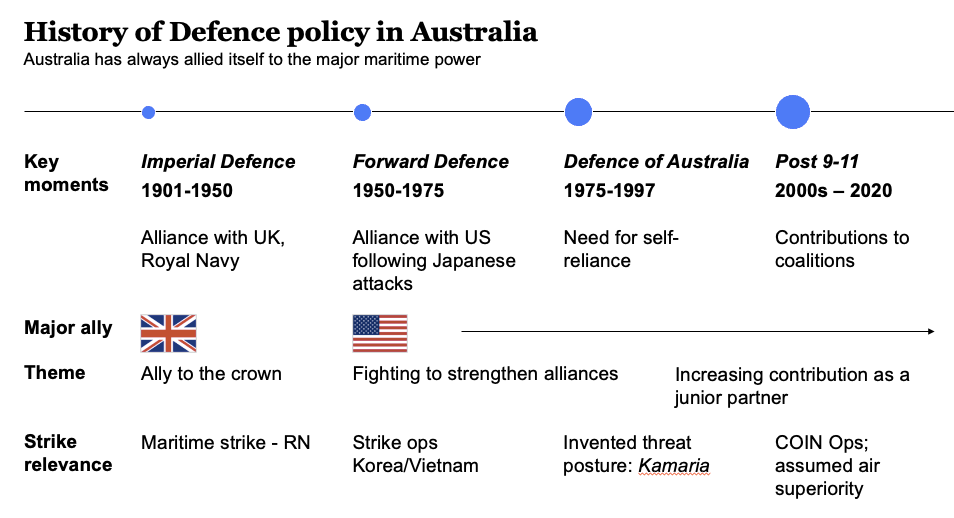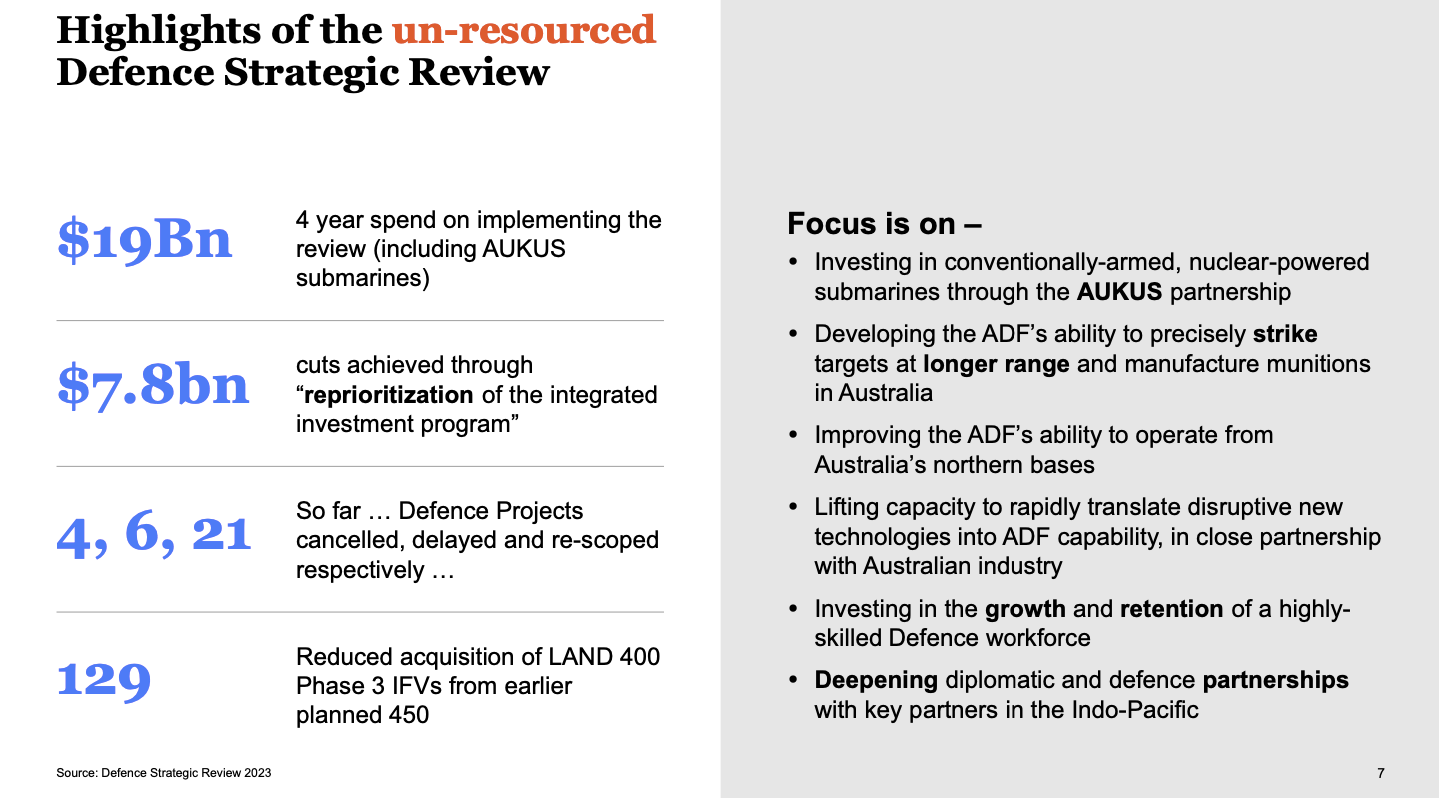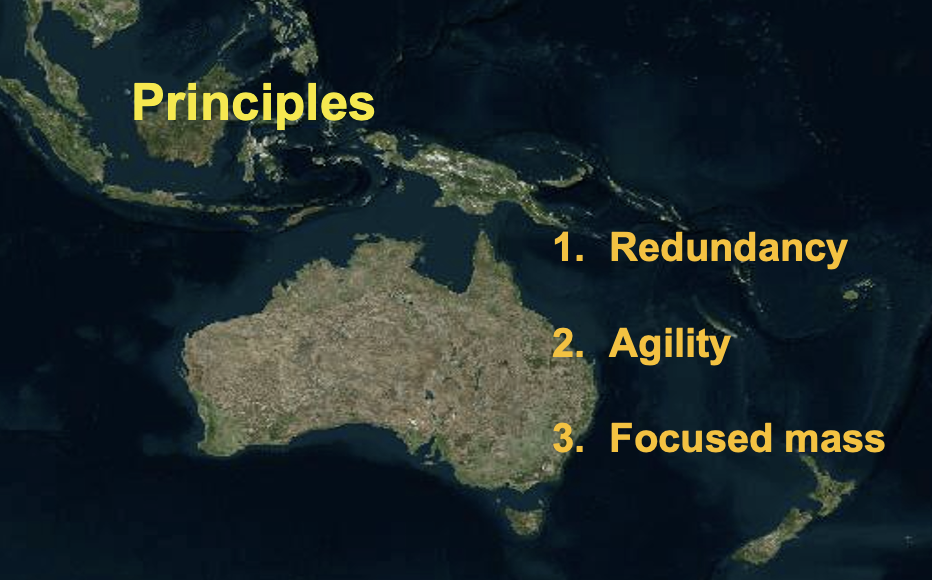The DSR and the Australian Strike Enterprise
We need to start first with considering how the 2023 Australian Defence Review has prioritized the need for enhanced ADF strike capabilities. In the review, the notion of enhanced strike capability entails shaping longer-range reach of those capabilities, the enhancement of joint strike capabilities and the shaping of an industrial base to support the strike enterprise transition.
Here is some of the language from the DSR regarding the strike enterprise:
“Due to the significant changes in Australia’s strategic circumstances, the Government agrees with the Review’s finding that the ADF as currently constituted and equipped is not fully fit for purpose. The Government deeply appreciates those who serve in the ADF and is committed to ensuring our people have the capabilities and resources they need. Delivering the Government’s vision and implementing the findings of the Review will require a more holistic approach to defence planning and strategy.

“Australia must have a fully integrated and more capable ADF operating across five domains which work seamlessly together on joint operations to deliver enhanced and joined-up combat power. Navy must have enhanced lethality – including through its surface fleet and conventionally-armed, nuclear-powered submarines – underpinned by a continuous naval shipbuilding program. Army must be optimised for littoral operations in our northern land and maritime spaces and provide a long-range strike capability. Air Force must provide the air support for joint operations in our north by conducting surveillance, air defence, strike and air transport. Defence must also continue to develop its cyber and space capabilities.
“The Government’s immediate actions to reprioritise Defence’s capabilities in line with the Review’s recommendations include: investing in conventionally-armed, nuclear-powered submarines through the AUKUS partnership; developing the ADF’s ability to precisely strike targets at longer range and manufacture munitions in Australia….” (Page 7).
A key focus is upon “an enhanced long-range strike capability in all domains.” (Page 19).
This is one of the justifications proffered for acquiring nuclear powered attack submarines. “The acquisition of conventionally-armed, nuclear-powered submarines will transform Navy’s capability. Nuclear-powered submarines are key assets both in effecting a strategy of denial and in the provision of anti-submarine warfare and long-range strike options.” (Page 56).
For Army this means: “Defence must rapidly accelerate and expand Army’s littoral manoeuvre vessels (medium and heavy landing craft) and long-range fires (land-based maritime strike) programs. This will require Army to re-posture key capabilities.” (Page 59).
This is translated in the DSR in terms of acquiring HIMARS and a land-based maritime strike capability. (Page 59).
For the RAAF, the B-21 is rejected as an acquisition option but there is an emphasis on “F-35A Joint Strike Fighter and F/A-18F Super Hornet aircraft must be able to operate the Long-Range Anti-Ship Missile. The Joint Strike Missile (JSM) should also be integrated onto the F-35A. To enable the F-35A fleet to operate the JSM, the aircraft will need to be upgraded to Block 4 configuration.” (Page 61).
And finally, Australia must build up its production capability in the strike area. “Long-range strike and other guided weapons are fundamental to the ADF’s ability to hold an adversary at risk in Australia’s northern approaches. To do this, the ADF must hold sufficient stocks of guided weapons and explosive ordnance (GWEO) and have the ability to manufacture certain lines.” (Page 68).
At the Williams Foundation seminar held on 27 September 2023 on the enterprise requirements of an Australian multi-domain strike capability, the former Air Commander Australia, Air Vice-Marshal (Retired) Zed Roberton discussed the DSR and strike. Roberton looked back at the history of ADF orientations and engagements and argued that until the 2020 defence initiative of the government, the ADF was equally balanced among three objectives: “Those were to defend Australia, look after the near region and to contribute to global coalitions as part of the global order. It was really interesting that those three objectives were equally weighted by design.”

After 2020 and in the recent DSR, the shift has been clearly to prioritizing Australian defence within the Indo-Pacific. And in so doing, he underscored that the focus is not just the defence of Australia to the North but a much broader focus on the Indo-Pac region. This means that Australia now faces a “four ocean front” in designing and operating its force in the defense of Australia.
But given the size of Australia as a continent, and the relatively small population, the ADF needs to be capable of generating agility to generate the mass required to make a significant strategic effect.
Roberton argued that the ADF needs to follow three principles to generate the capability needed for agility and force integration to achieve a desired strategic effect. The first is redundancy, not resilience. “We have too many single points of failure. The multi-domain approach provides a way to focus on redundancy in strike.”
The second is agility. Roberton underscored: “When you’ve got a small number of people in a defense force with a small base, your ability to bring about an effect around the continental landmass or its approaches and hold forces at risk further from Australia requires agility. And a level of agility not just in capabilities, but in our procedures and processes.”
The third is focused mass. This obviously is the goal of multi-domain strike, to have an ability for an agile force to concentrate across multiple domains the desired strategic effect. Going forward, Roberton argued that “we will see a massive focus on things like uncrewed aerial vehicles, uncrewed sea vehicles or land vehicles, the ability to have pre-positioned missile systems and of course, synchronized with cyber and in space effects.”
He concluded that two questions are critical moving forward which we need to consider. “How does Australia hold adversary forces at risk further from our shores? And and what does next generation deterrence really look like?”
But he warned that the question of both resourcing and prioritization in defence raises real challenges for the kind of force adapation which Australia will need. He provided a slide in his presentation which highlighted the extent of the budget challenge.

Put in simple terms: how does Australia pay for its nuclear submarine project and at the same time source the overall ADF transition to a multi-domain capable defence force?

